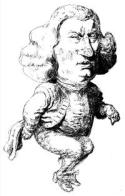Our patron, Gordon Turnbull, General Editor of the Yale Boswell Editions, sends us from New Haven, Connecticut some of the latest news on the great collection, much of which is now being scanned and some of which is already available on line on the internet:
Yale’s Beinecke Rare Book and Manuscript Library, which houses the vast Boswell Collection, has embarked on a series of scans of selected Boswellian materials, and some of these treasures are now available online.
Johnsonians will know already, of course, of the remarkably labyrinthine manuscript of The Life of Johnson, a heavily revised master text with blizzards of attendant satellite documents (usually called “Papers Apart” and cued in to the main text by various sigla), amounting, in Frank Brady’s words, to a “wondrous tangle” which a modern printer would reject “at sight” (James Boswell: The Later Years, 1769-1795, p. 286)).
Two volumes have been published so far in the Yale Life manuscript transcription, in the complex but accessible system devised by Marshall Waingrow for vol. 1 (1994) and continued by Bruce Redford, with Elizabeth Goldring, for vol. 2 (1998).
The Beinecke’s digitalized images now allow a more directly visual sense of Boswell’s processes and principles of selection and revision, as he—goaded and guided by and his friend and editor Edmond Malone – made his way through the wondrous tangle of documents. The main pages of the Life are online, and most of the Papers Apart have been prepared, with scannings underway. Volumes 3 and 4 of the Yale transcription are now also underway, in the hands of Professor Thomas F. Bonnell. Stand by for publication dates .
The Beinecke has also made available a scan of the manuscript of Boswell’s vibrant youthful “Journal from the time from my leaving Scotland 15 November 1762”, better known as Boswell’s London Journal, 1762-1763, the title given by Frederick A. Pottle when he edited it, with modernized spelling and punctuation, in 1950 as the first in the Yale trade edition series of Boswell’s journals. It remains Boswell’s most popular, and most frequently read and taught, portion of diary.
The scans include Boswell’s surviving daily private Memoranda, omitted from Pottle’s edition, as not forming part of the journal as originally written and send to Boswell’s friend and first reader, John Johnston of Grange, but which are biographically revealing nonetheless. Log on to http://beinecke.library.yale.edu/dl_crosscollex, and type “Life of Johnson”, “London Journal”, or “London Memoranda” in the “Submit Search” line.
Plans are advancing also for scans also for the manuscript of Boswell’s Journal of a Tour to the Hebrides with Samuel Johnson LL.D. Readers will see there restored much of the material deleted by Boswell and Malone as they reworked Boswell’s original diary into a memoir of Johnson, much of which material directly concerns the Scots of the Highlands and Western Isles making the culturally and socially arduous transition in modern post-Culloden ‘Britain’.
The next volume in the acclaimed and authoritatively annotated Yale Research Series is now in its indexing stages, and should appear from Edinburgh University Press and Yale University Press in either late 2004 or early 2005. The General Correspondence of James Boswell, 1757-1763, edited by David Hankins and James J. Caudle, assembles most of the earliest correspondence to and from Boswell, from the period of his rebellious pleasure among actors and other theatre people in Edinburgh to the time that saw his momentous and life-changing first meeting with Johnson in London.

